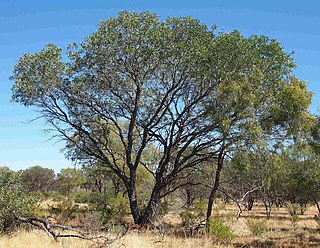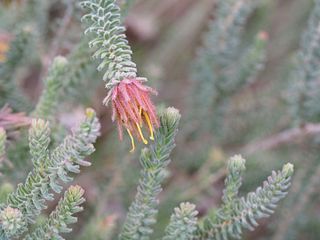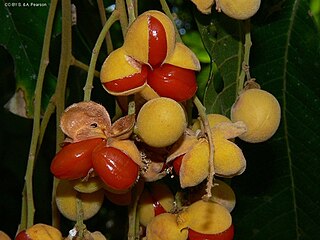
Dichopogon strictus, commonly known as chocolate lily, is a herbaceous perennial plant species native to Australia.

Acacia pruinocarpa, commonly known as black gidgee, gidgee or tawu, is a tree in the family Fabaceae that is endemic to arid parts of Australia.

Callitris columellaris is a species of coniferous tree in the family Cupressaceae, native to most of Australia. Common names include white cypress, white cypress-pine, Murray River cypress-pine, and northern cypress-pine. Callitris columellaris has become naturalised in Hawaii and in southern Florida.

Alpinia caerulea, commonly known as native ginger or Australian ginger, is an understorey perennial herb in the family Zingiberaceae which grows in rainforest, gallery forest and wet sclerophyll forest in eastern Australia.

Chenopodium curvispicatum is a species of plant in the family Amaranthaceae, endemic to Australia.

Capparis anomala is a species of flowering plant, commonly called warrior bush or broom bush, which is native to Australia.

Pseuderanthemum variabile, commonly known as pastel flower or love flower in its native range, or night and afternoon in the USA, is a small perennial herb in the family Acanthaceae which is native to Australia, Papua New Guinea and New Caledonia. It can be an unwelcome nuisance in orchid nurseries in Australia.

Nymphaea gigantea, commonly known as the giant waterlily or blue waterlily, is a perennial, herbaceous plant in the family Nymphaeaceae which is native to parts of northern and eastern Australia, and it has been widely cultivated elsewhere. It is an aquatic plant whose natural habitat is permanent and semi-permanent still water bodies

Darwinia chapmaniana, commonly known as Chapman's bell or Eganu bell, is a plant in the myrtle family Myrtaceae, and is endemic to the south-west of Western Australia. It is a low, rounded, spreading shrub with greyish, hairy leaves and flowers in heads of about 14 small, tubular flowers. The heads are surrounded by long, reddish-yellow, hairy bracts.

Boronia xanthastrum is a species of small shrub that is endemic to the Northern Territory. It has yellow, star-like hairs on the young branches, leaves and parts of the flowers, elliptical to lance-shaped leaves and small yellowish green flowers.

Dianella amoena, commonly known as the matted flax-lily, is an endangered, herbaceous, perennial plant endemic to Australia. It belongs to the family Asphodelaceae, subfamily Hemerocallidoideae. It has long grey-green leaves which grow in clumps from an underground rhizome, and displays blue-purple flowers in spring-summer, up to 90cm in height. The common name Matted Flax-lily refers to its extensively rhizomatous nature, sometimes forming large mats up to 5m wide.

Goodenia triodiophila, commonly known as spinifex goodenia in the Northern Territory, is a species of flowering plant in the family Goodeniaceae and is endemic to arid inland areas of Central Australia. It is a stiff, wiry, much-branched, ascending perennial herb with needle-shaped or linear leaves on the stems and racemes of yellow flowers with a brownish centre.

Myristica insipida, commonly known in Australia as Australian nutmeg, Queensland nutmeg or native nutmeg, is a small rainforest tree in the family Myristicaceae native to parts of Malesia, Papuasia and Australia. It is closely related to the commercially-important species of nutmeg, M. fragrans.
Lechenaultia striata is a species of flowering plant in the family Goodeniaceae and is endemic to arid inland areas of Australia. It is an ascending herb or subshrub with only a few wand-like branches, crowded, narrow fleshy leaves and pale blue to pale yellow or creamy-white flowers.

Alyxia oblongata, commonly known as the chain fruit, prickly lixy, or prickly Alyxia, is a plant in the dogbane family Apocynaceae endemic to a small part of northeastern Queensland.

Cleistanthus apodus, commonly known as the weeping Cleistanthus, is a tree in the family Phyllanthaceae native to New Guinea and northeast Queensland. It was first described in 1873 by the English botanist George Bentham in his seven-volume book Flora Australiensis.

Pittosporum ferrugineum, commonly known as the rusty pittosporum or rusty-leaved pittosporum, is an evergreen plant in the family Pittosporaceae native to Malesia, Papuasia, the Northern Territory and Queensland.

Diploglottis diphyllostegia, commonly known as the northern tamarind, native tamarind or wild tamarind, is a tree in the lychee family Sapindaceae which is endemic to Queensland, Australia. It is an attractive tree with potential in cultivation, with a dense crown of dark green leaves and masses of fruit in spring and summer.

Diploglottis obovata, commonly known as blunt-leaved tamarind, is a plant in the family Sapindaceae endemic to central eastern Queensland, Australia. Until 1987 it was considered to be a form of the very closely related Diploglottis diphyllostegia.

Cupaniopsis flagelliformis, commonly known as brown tuckeroo or weeping flower tamarind, is a tree in the lychee, guaraná and maple family Sapindaceae which is endemic to eastern Australia. It is a small tree that inhabits drier or seasonal rainforests.




















